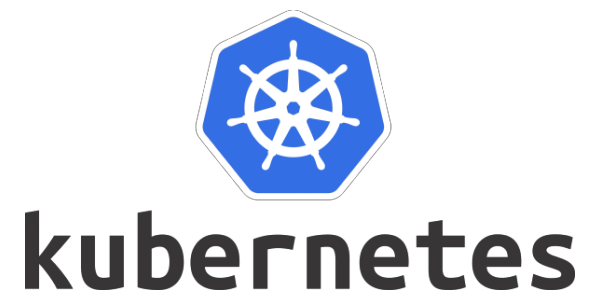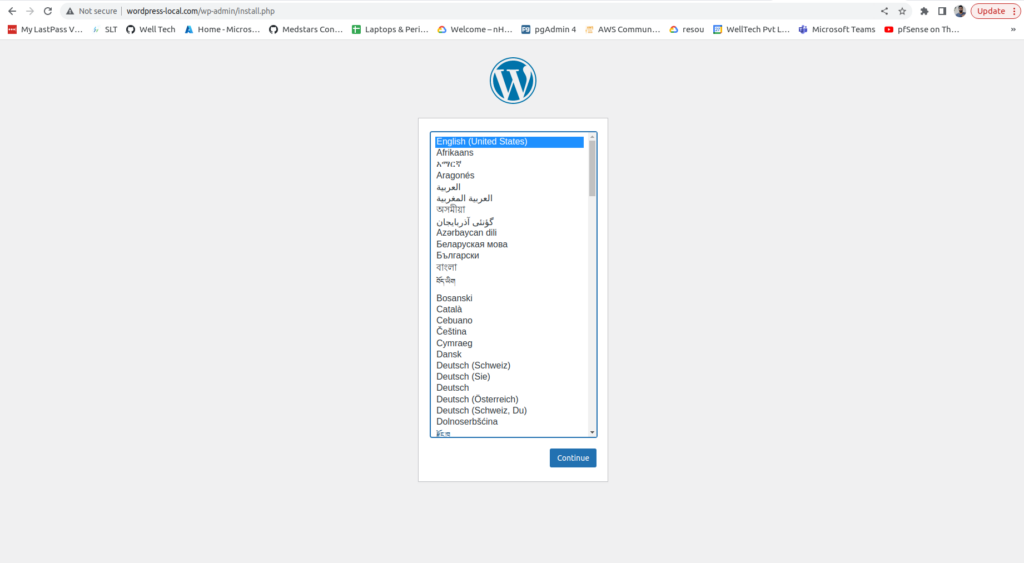
Github Source Code : https://github.com/NadunOvitigala/wordpress-mysql-kubernetes-ingress-yaml/tree/main
How to run
Clone the repo to your local
git clone https://github.com/NadunOvitigala/wordpress-mysql-kubernetes-ingress-yaml.gitApply and Verify
kubectl apply -k ./
kubectl get pods
Edit /etc/hosts like bellow
Get node Internal IP
kubectl get nodes -o wide

Edit /etc/hosts like bellow
ADD NodeIP : 192.168.49.2 SITE-URL : wordpress-local.com
Type wordpress-local.com URl on you browser.

Source Code Explain
wordpress-deployment.yaml
apiVersion: v1
kind: Service
metadata:
name: wordpress-service
labels:
app: wordpress-service
spec:
ports:
- port: 80
selector:
app: wordpress
tier: frontend
type: LoadBalancer
This section defines a Kubernetes Service named “wordpress-service.” A Service is used to expose a set of pods as a network service. It listens on port 80 and forwards traffic to pods that have the labels “app: wordpress” and “tier: frontend.” This Service is of type “LoadBalancer,” which means it will create an external load balancer to distribute incoming traffic to the WordPress pods.
---
apiVersion: v1
kind: PersistentVolumeClaim
metadata:
name: wp-pv-claim
labels:
app: wordpress
spec:
accessModes:
- ReadWriteOnce
resources:
requests:
storage: 20Gi
This section defines a PersistentVolumeClaim (PVC) named “wp-pv-claim.” A PVC is used to request storage resources from a storage class. In this case, it requests 20GB of storage with the access mode “ReadWriteOnce,” which means it can be mounted by a single pod for both reading and writing.
---
apiVersion: apps/v1
kind: Deployment
metadata:
name: wordpress
labels:
app: wordpress
spec:
selector:
matchLabels:
app: wordpress
tier: frontend
strategy:
type: Recreate
template:
metadata:
labels:
app: wordpress
tier: frontend
spec:
containers:
- image: wordpress:6.2.1-apache
name: wordpress
env:
- name: WORDPRESS_DB_HOST
value: wordpress-mysql
- name: WORDPRESS_DB_PASSWORD
valueFrom:
secretKeyRef:
name: mysql-pass
key: password
- name: WORDPRESS_DB_USER
value: wordpress
ports:
- containerPort: 80
name: wordpress
volumeMounts:
- name: wordpress-persistent-storage
mountPath: /var/www/html
volumes:
- name: wordpress-persistent-storage
persistentVolumeClaim:
claimName: wp-pv-claim
This section defines a Kubernetes Deployment for the WordPress application. A Deployment manages a set of replicated pods. Here are the key details:
- The Deployment is named “wordpress” and labeled as “app: wordpress.”
- The Deployment specifies that it should manage pods with labels “app: wordpress” and “tier: frontend.”
- The strategy for managing pods is set to “Recreate,” which means existing pods will be terminated and new ones will be created when updates are made.
- The template section describes the pod template. It specifies the container image, environment variables (for connecting to a MySQL database), ports, and volume mounts.
- A volume named “wordpress-persistent-storage” is mounted at “/var/www/html” in the WordPress container, and it is associated with the PersistentVolumeClaim “wp-pv-claim” defined earlier. This allows WordPress to store its data persistently.
mysql-deployment.yaml
apiVersion: v1
kind: Service
metadata:
name: wordpress-mysql
labels:
app: wordpress
spec:
ports:
- port: 3306
selector:
app: wordpress
tier: mysql
clusterIP: NoneIn this section, you are defining a Kubernetes service named “wordpress-mysql” that exposes the MySQL database. The service has no cluster IP, indicating that it’s not accessible outside the cluster. It uses labels to select pods with the “app: wordpress” and “tier: mysql” labels. Port 3306 is exposed for MySQL traffic.
apiVersion: v1
kind: PersistentVolumeClaim
metadata:
name: mysql-pv-claim
labels:
app: wordpress
spec:
accessModes:
- ReadWriteOnce
resources:
requests:
storage: 20Gi
This section defines a Persistent Volume Claim (PVC) named “mysql-pv-claim.” It requests 20Gi of storage with the “ReadWriteOnce” access mode. This claim is used to ensure that the MySQL data is stored persistently.
apiVersion: apps/v1
kind: Deployment
metadata:
name: wordpress-mysql
labels:
app: wordpress
spec:
selector:
matchLabels:
app: wordpress
tier: mysql
strategy:
type: Recreate
template:
metadata:
labels:
app: wordpress
tier: mysql
spec:
containers:
- image: mysql:8.0
name: mysql
env:
- name: MYSQL_ROOT_PASSWORD
valueFrom:
secretKeyRef:
name: mysql-pass
key: password
- name: MYSQL_DATABASE
value: wordpress
- name: MYSQL_USER
value: wordpress
- name: MYSQL_PASSWORD
valueFrom:
secretKeyRef:
name: mysql-pass
key: password
ports:
- containerPort: 3306
name: mysql
volumeMounts:
- name: mysql-persistent-storage
mountPath: /var/lib/mysql
volumes:
- name: mysql-persistent-storage
persistentVolumeClaim:
claimName: mysql-pv-claim
This is the most complex section, defining a Kubernetes Deployment for the MySQL database. Here’s a breakdown:
- The deployment is named “wordpress-mysql” and has labels “app: wordpress.”
- It selects pods based on the labels “app: wordpress” and “tier: mysql.”
- It uses a “Recreate” strategy, which means old pods are deleted before new ones are created.
- The pod template specifies the container to run, which is MySQL 8.0.
- It sets environment variables for MySQL configuration, such as the root password, database name, user, and password. Some secrets are used here (e.g., “mysql-pass”).
- Port 3306 is exposed for MySQL connections.
- It defines a volume mount for persistent storage, ensuring that the MySQL data is stored on the volume claimed earlier.
kustomization.yaml
secretGenerator:
- name: mysql-pass
literals:
- password=YOUR_PASSWORD
In this section, you are defining a Kubernetes Secret Generator, which is used to create a secret. A secret is a Kubernetes resource used to store sensitive data, such as passwords, tokens, or other confidential information. In this case, it’s creating a secret named “mysql-pass” with a single key-value pair: “password” with the value “YOUR_PASSWORD.” You should replace “YOUR_PASSWORD” with your actual password when using this YAML file.
resources:
- mysql-deployment.yaml
- wordpress-deployment.yaml
This section specifies the resources that will be applied as part of the Kubernetes deployment. It references two separate YAML files: “mysql-deployment.yaml” and “wordpress-deployment.yaml.” These files likely contain the definitions for Kubernetes Deployments, which are used to manage the lifecycle of applications running on the cluster. These deployment files would typically include specifications for pods, services, and other resources needed for your MySQL and WordPress applications.
ingress.yaml
apiVersion: networking.k8s.io/v1
kind: Ingress
metadata:
name: wordpress-ingress
spec:
rules:
- host: wordpress-local.com
http:
paths:
- path: /
pathType: Prefix
backend:
service:
name: wordpress-service
port:
number: 80The Kubernetes YAML file defines an Ingress resource, which plays a crucial role in managing external access to services within a Kubernetes cluster. This resource is named “wordpress-ingress” and is configured to handle incoming HTTP traffic with the hostname “wordpress-local.com.” The routing is specified using the rules section, where any requests to the root path (“/”) or its subpaths will be directed to the Kubernetes service named “wordpress-service” on port 80. The “pathType” is set to “Prefix,” which allows for flexible routing of various subpaths to the same backend service. This configuration is commonly used when hosting web applications, ensuring that traffic to a specific hostname is efficiently directed to the appropriate service within the cluster.
Thank You!!
